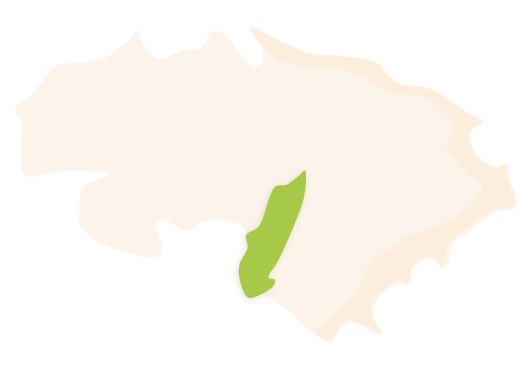Xaló, a municipality in La Vall de Pop, is located in the southwest of the inland area of La Marina Alta. Sitting at 189 metres above sea level, it covers an area of 34.6 km² that runs between mountainous terrain in the south and the fertile plain on the banks of the Xaló-Gorgos River. It has 2,892 inhabitants, who are known as Xaloners and Xaloneres.
 Xaló's municipal district. Surface area: 34.60 km². Population: 2,892 (INE data 2021).
Xaló's municipal district. Surface area: 34.60 km². Population: 2,892 (INE data 2021).HISTORY
Xaló is located in the current terrain of La Vall de Pop together with Parcent, Alcalalí and Llíber, although its historical area is related to the castle of Aixa.
The first human settlements in the area date back to prehistoric times. Materials ranging from the Neolithic to the Middle Ages have been discovered in the cave known as Les Meravelles de La Solana, and examples of Levantine rock paintings along with materials from the Bronze Age have been discovered in the Mansano cave.
With regards to the Iberians, one can find fortified, hilltop villages in Aixa and Marge Llarg. With the arrival of the Romans, several more villages began to occupy the area. These were dedicated to oil, wheat and, above all, wine, as shown by the ovens that have been discovered in the archaeological site known as Les Hortes de Xaló, where the amphorae necessary for the transport of oil and wine were made.
The origin of the town of Xaló, as we know it, dates back to the Middle Ages with the Muslim farmsteads of El Ràfol de Xaló and Benixaloni. In the period of Al-Andalus, the hîsn or castle of Aixa would have been the administrative head under the protection of which were to be found several farmsteads, including the current municipalities of Alcalalí, Xaló and Llíber. The castle of Aixa’s administrative district had 13 settlements and 5 farmsteads (Allbayren, Alquellelin, Atrayello, Beniatia, Benibrahim, Beniquasi, Benixaloni, Ràfol, Cotar, Cura, Losa, Murta, Arrayán, Muscayra and Allybait, today's Llíber).
With the arrival of the Christians, the donations and lordships changed from hand to hand, but in 1408 Pere de Castellví, as lord of Alcalalí, Llíber and Xaló, sold the latter of the three and its land to Jaume Verdeguer. The former territory of the castle of Aixa was thus divided into two lordships, which would be the origin of the baronies of Alcalalí-Mosquera and Xaló-Llíber. From 1413 to 1444, the latter formed part of the estate of the Martorell family, lineage to which belonged the famous novelist, Joanot Martorell.
After the expulsion of the Moors, severe depopulation forced Xaló and Llíber to be granted a town charter in 1611, resulting in repopulation with villagers from the Balearic Islands. These new residents became serfs, cultivating the land under the feudal regime. The unrest produced by the harsh conditions set out in the town charter gave rise to the 1693 rebellion known as Segona Germania, one that was particularly intense in Xaló. The second third of the 20th century was marked by a strong economic recession that forced many people from Xaló, and La Marina Alta in general, to emigrate to Argentina and Algiers.
The municipality offers visitors many opportunities to purchase regional and traditional products with shops, bodegas and a cooperative, along with the various markets, including El Mercat Tradicional, El Mercat d’Antiguitats and El Mercat de La Terra.
FESTIVITIES
- The festivities of Saint Domènec are celebrated at the beginning of August in honour of Saint Domènec de Guzmán.
- The festivities in honour of the patron saint of Xaló, La Mare de Déu Pobra, are celebrated on the third Sunday of October.
- The festivities known as “Les Festes del Romer” are celebrated on the last Saturday in April.
- The antiques street market known as “El Mercat del Rastro” takes place every Saturday.
- The market known as “El Mercat de la Terra” is held on the first Saturday of each month.
GASTRONOMY
- “Arròs amb fesols i naps” (wet rice dish with beans and turnip).
- Cured meats and cold cuts.
- “Guisat de caragols” (snail stew).
- “Bollos de pésols” (green pea buns).
- Wine and “mistela” (regional dessert wine).